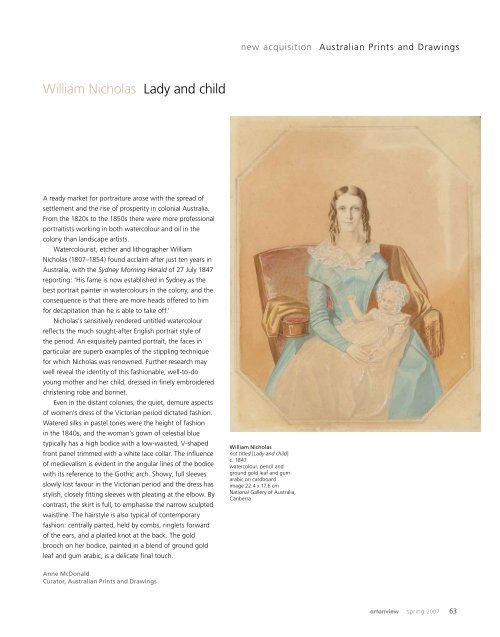Art Ew - National Gallery of Australia
Art Ew - National Gallery of Australia
Art Ew - National Gallery of Australia
You also want an ePaper? Increase the reach of your titles
YUMPU automatically turns print PDFs into web optimized ePapers that Google loves.
William Nicholas Lady and child<br />
A ready market for portraiture arose with the spread <strong>of</strong><br />
settlement and the rise <strong>of</strong> prosperity in colonial <strong>Australia</strong>.<br />
From the 1820s to the 1850s there were more pr<strong>of</strong>essional<br />
portraitists working in both watercolour and oil in the<br />
colony than landscape artists.<br />
Watercolourist, etcher and lithographer William<br />
Nicholas (1807–1854) found acclaim after just ten years in<br />
<strong>Australia</strong>, with the Sydney Morning Herald <strong>of</strong> 27 July 1847<br />
reporting: ‘His fame is now established in Sydney as the<br />
best portrait painter in watercolours in the colony, and the<br />
consequence is that there are more heads <strong>of</strong>fered to him<br />
for decapitation than he is able to take <strong>of</strong>f.’<br />
Nicholas’s sensitively rendered untitled watercolour<br />
reflects the much sought-after English portrait style <strong>of</strong><br />
the period. An exquisitely painted portrait, the faces in<br />
particular are superb examples <strong>of</strong> the stippling technique<br />
for which Nicholas was renowned. Further research may<br />
well reveal the identity <strong>of</strong> this fashionable, well-to-do<br />
young mother and her child, dressed in finely embroidered<br />
christening robe and bonnet.<br />
Even in the distant colonies, the quiet, demure aspects<br />
<strong>of</strong> women’s dress <strong>of</strong> the Victorian period dictated fashion.<br />
Watered silks in pastel tones were the height <strong>of</strong> fashion<br />
in the 1840s, and the woman’s gown <strong>of</strong> celestial blue<br />
typically has a high bodice with a low-waisted, V-shaped<br />
front panel trimmed with a white lace collar. The influence<br />
<strong>of</strong> medievalism is evident in the angular lines <strong>of</strong> the bodice<br />
with its reference to the Gothic arch. Showy, full sleeves<br />
slowly lost favour in the Victorian period and the dress has<br />
stylish, closely fitting sleeves with pleating at the elbow. By<br />
contrast, the skirt is full, to emphasise the narrow sculpted<br />
waistline. The hairstyle is also typical <strong>of</strong> contemporary<br />
fashion: centrally parted, held by combs, ringlets forward<br />
<strong>of</strong> the ears, and a plaited knot at the back. The gold<br />
brooch on her bodice, painted in a blend <strong>of</strong> ground gold<br />
leaf and gum arabic, is a delicate final touch.<br />
Anne McDonald<br />
Curator, <strong>Australia</strong>n Prints and Drawings<br />
new acquisition <strong>Australia</strong>n Prints and Drawings<br />
William Nicholas<br />
not titled [Lady and child]<br />
c. 1847<br />
watercolour, pencil and<br />
ground gold leaf and gum<br />
arabic on cardboard<br />
image 22.4 x 17.6 cm<br />
<strong>National</strong> <strong>Gallery</strong> <strong>of</strong> <strong>Australia</strong>,<br />
Canberra<br />
artonview spring 2007 63

















